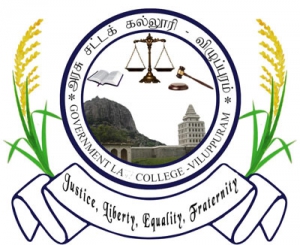GOVERNMENT LAW COLLEGE,
VILUPPURAM – 605602
LOGO – Explanatory Notes
The logo of Government Law College, Viluppuram – 605602 consist of the following parts
Part – I : Two Concentric Circles
Part – II : Fluttering Ribbon
Part – III : Two Paddy Twigs
Part – I
The Part – I of the Logo comprises of two concentric circles with name of the institution in Tamil and English with blossom separation, Gingee Fort, Scales of Justice, Open Book and Gavel.
The Inner Concentric Circle has the following
-
The Gingee Fort
The Gingee Fort in the logo is to represent the Cultural, Historical, Archeological importance of the Viluppuram District with a history from Jains, Pallavas, Cholas, Pandyas, Hoysalas, Kons, Vijayanagar, Muhammaadans, Mughals, French, and Britishers. This is to show the Cultural, Historical, Archeological importance of the place, where the Institution is located.
In comparison with evidences available from other sources like the evidence of rock-cut inscription of Jain monk Chandranandhi and from the evidences of rock-cut beds of Jains, historians strongly believe that Jains lived in Gingee from 200 B.C. in 500 A.D.
The Gingee was under the rule of Pallavas, Cholas, Pandyas, Hoysalas, Kons from 600 A.D to 1330 A.D. The Forts ‘Anandha Giri’ latter called as ‘Raja Giri’ and ‘Krishna Giri’ at Gingee were built during this period. The Gingee was under the rule of Vijayanagar Kings during the 14th Century A.D, who build tall and strong fort walls with granite, sculptural workmanship, similar to that of the architecture in ‘Hampi’. The Gingee Fort was under the rule of Muhammaadans from 1649 A.D. to 1677 A.D. The Gingee Fort was under the Marathas from1677 A.D. to 1697 A.D. After this Desingh Raja ruled for short period, he deeply engraved his marks in the history of Gingee Fort. From 1700 A.D. to 1750 A.D. it was under the rule of Mughals. Gingee Fort was under the rule of the French from reference from 1750 A.D till April, 1761 A.D after which it was under the control British.
Today Gingee fort is placed as a memorial in the pages of history for it’s Cultural, Historical, Archeological importance.
-
The Scales of Justice
The balance is probably the oldest symbol that embodies the judicial function. The balance represents the ultimate judgment, harmony, order and fairness. It also refers to the idea of measurement. It reminds the first goal of justice (reconciliation and conflict mitigation) and the way to do it (adjudicates between the rights of the parties). The balance embodies the impartiality of justice. This is a non-violent symbol, advocating social peace and conciliation.
-
Open Book
Open book signifies education, knowledge and wisdom. An open Book symbolizes information that is available to everyone. An open Book is a Symbol for common, everyday exoteric knowledge or information available to all. The Marking of the thread in the open book signifies the continuity of flow of knowledge made available to the member participants throughout.
-
Judge’s Gavel
Judge’s Gavel is a symbol of the authority and right to act officially. The expression passing the gavel signifies an orderly succession from one to another. A Judge’s gavel is used to call for attention or to punctuate rulings and proclamations.
The Outer Concentric circle has the name of the Institution in Tamil and in English with two blossoms to differentiate the bilingual name of the institution. The blossoms is representing the flourishing institution as a knowledge centre.
Part – II
The Part-II is a fluttering ribbon at the bottom with the inscription of Justice, Liberty, Equality, Fraternity in calligraphy letter style. This to represent the objectives of the Indian Constitution. The Indian Constitution guarantees Justice, Liberty, Equality, Fraternity to all the citizens of our country. The calligraphy letter style is the letter style in which the constitution was originally handwritten and maintained till date in the parliament of India. This part represents the intention of the institution to fulfill the constitutional commitment.
Part – III
The Part – III is Two Paddy Twigs on both sides. This is to represent the major occupation of the district in which the institution is located. Agriculture is the mainstay of the people in the Viluppuram district. The major grown in the district is paddy. Viluppuram district is at the top with production of nearly 480329 tonnes of paddy followed by Thanjavur district 479643 tonnes from 2007 – 2008 (Source: Department of Economics and Statistics, Chennai-600 006).

